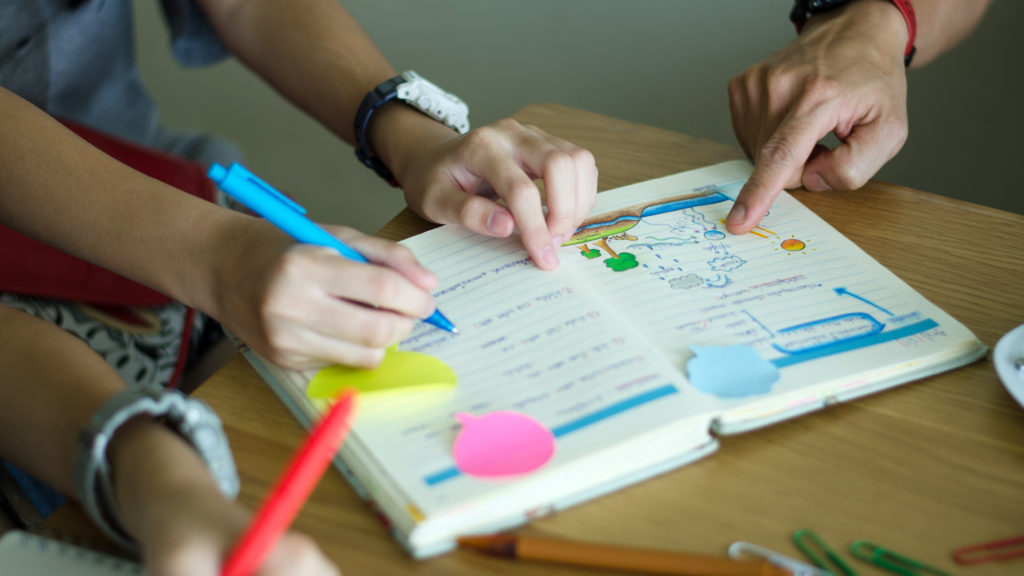The need to better engage families became starkly apparent during a school year flipped on its head by a global pandemic. Yet there remains a possibility that the realities COVID-19 exposed can help forge a new social contract between schools and families, placing parents in partnership as co-educators with teachers. With that in mind, CRPE set out to assess what family-teacher partnerships have looked like in high school throughout the pandemic—paying close attention to promising new developments and enduring areas of need.
In work funded by the Barr Foundation, CRPE conducted longitudinal interviews with teachers and parents across five New England school districts from January to May 2021. We asked about how schools and educators engaged families to support high school students, what strategies worked best, and what gaps surfaced.
We found that parents and teachers discovered value in enhanced opportunities to collaborate with one another. Many teachers engaged in more creative and sustained parent outreach, but with considerable inconsistency in expectations and practice. Some families, particularly those with limited English or limited technological access, remained shut out of the opportunities provided by deeper collaboration. Addressing uneven communication between teachers and parents, language and cultural competency barriers, and inequitable access to technology will require school systems to invest in family partnerships in ways most have not yet attempted.
Teachers and parents say there is benefit to more collaboration—and want it to continue
Educators emphasized the need for creative strategies to reach families and adapted strategies, new and old, to foster collaboration. Interviews revealed that despite challenges, schools are reaching out through the virtual walls—in some places, in any way necessary. A teacher in central Connecticut shared her cell phone with parents and reached out to students on social media to check on their well-being. Another teacher at the same school noted that during the pandemic parents requested she contact them when their children missed class—something that didn’t happen before the pandemic. ”Overall, collaboration has increased out of necessity,” she confessed.
Parents and teachers noted that with more consistent communication and collaboration, students were more motivated to learn. A teacher in the Boston area started texting parents more regularly (about every three weeks) regarding her students’ grades. She found one of her students went from a D to B after she started this practice.
One school district in Maine began prioritizing relationship building and collaboration through new tutoring supports being developed with federal funds. The supports are built to provide not only academic, but whole-child/family support. One parent shared, “The academic tutoring support is probably about 15 to 27 percent. Eighty percent of it is relationship building, trust building, one-on-one attention, coping with family needs and emotional and mental health issues students might have going on due to the changes that COVID has brought.”
The pandemic has shone a spotlight on the fact that close collaboration between teachers and parents of adolescents has been missing for some time. A parent from Rhode Island spoke to the importance of increased communication with her child’s teacher: “This year reinforced that parents, especially those of adolescents, still need to support and motivate their children to get through those formative years as they become adults,” she shared. “Parents can’t allow the schools to try and do it all.”
The parent’s awareness that she was an essential partner in her adolescent’s education was highlighted during the pandemic. “Placing responsibility solely on the student to choose a course load for the following year is an unreasonable expectation,” she cautioned. “Not every student has the capacity to figure that out on their own.”
Uneven standards of communication
While some teachers used every resource available to communicate with their students, others only communicated with families when things were going awry—reaching out only when a student was consistently absent from class, for example. And some didn’t reach out enough, creating uneven access to teachers in a year when communication was critically important.
One parent in Connecticut expressed frustration at unclear communication on tech platforms meant to keep parents informed of their children’s academic progress. “Teachers expect a lot, but sometimes they don’t report grades when they’re supposed to, so it messes with my kid’s term grade. She’ll get a Semester Two term grade, yet the work isn’t in, and I’ve seen her email the teacher several times to ask, ‘Have you put the test grade in yet?’ And they’re like, ‘I’m going to get to it. I’m going to get to it.’ I get mad because I’m like, ‘You’ve been cooperating, you’ve been staying in touch with them, so I don’t understand why they didn’t grade it when they were supposed to.’”
A single father in Rhode Island admitted frustration when it came to the stilted communication from his son’s school: the lack of clarity on how much time his son should spend on Zoom for class and, more troubling, the amount of time he was missing class. The father was not contacted until his son had missed 30 days of classes.
“Teachers seem to be worried about overburdening parents or telling them bad news about students, but this parent wishes he got better communication from teachers and better accountability for his students,” he expressed.
This father noted that over time, communication did improve. By April 2021, he reported: “On the PowerSchool app, the teachers are responding more to me, which is fantastic. I don’t know if it’s because it’s getting near the end of the year or just because we’ve had time to get this down, but I am getting a little more communication from their schools.” PowerSchool has been considered a “helpful” tool utilized by multiple schools to help parents stay informed of the progress of their children, and stay engaged with their teachers.
Uneven access to technology
While tech has been omnipresent this year, not every family feels competent to navigate new tools, which can create barriers in access that some schools and districts must work more vigorously to overcome. One parent in Rhode Island received online progress reports throughout the pandemic. However, she couldn’t view them because she doesn’t have a computer or comprehension of how to access the online system. As a result, the updates she receives about her child’s learning is solely through infrequent parent-teacher conferences.
A parent of a Connecticut high schooler shared that her son’s academics went from honors Spanish and advanced math to the basic level in both subjects after his school district shifted to a hybrid school model. Though her son possessed technological resources, she was ill-equipped to assist him with accessing them. When asked what she might request from the school to better support her son academically, she suggested paper copies of his homework could be sent to their home. Exasperated with being unable to get in touch with her son’s teachers, she experienced an overwhelming sense that she had no power to help him succeed academically while his motivation spiraled.
“I haven’t really gotten any support,” she shared. “His science teacher has probably been the only person that has actually reached out to me and said, ‘He needs to do his work.’” The only way this parent found she could support her son was by calling in sick and staying home from one of the three jobs she works to support her family. Even then, the support she was able to offer was limited because of her lack of understanding of the technical systems her son’s school used.
Ineffective communication/cultural outreach
If the goal is equitable access for all families, parents who do not speak English fluently need reliable engagement with teachers who can cultivate effective and culturally competent ways to communicate with them. While several families and teachers reported that communication improved during the pandemic, the gains were significantly less for culturally diverse families or families from limited English-speaking backgrounds.
The Rhode Island parent who doesn’t own a computer confided that there isn’t much that she can do to help her children with their schoolwork because she doesn’t speak or read English. In addition, one of her children has a disability, yet she hasn’t had a proper translator for IEP (Individualized Education Program) meetings.
“We need to make sure that we have proper translators in parent/teacher meetings translating for our Cape Verdean parents,” shared one teacher in Rhode Island, whose school serves a large population of Portuguese-speaking families. “We use our own district employees who are not certified to translate to Portuguese at these meetings. I think because of that, there was a lack of understanding of what certain terminologies mean. We need to be able to explain things to families in the ways they can understand them.”
One school in the Boston area tapped educators who have language and cultural fluency to reach out and communicate with families whose first language is not English. A teacher shared a story of a school administrator who is fluent in Spanish and began reaching out to parents of students at risk of not graduating because of failing grades. These practices emerged out of the need to reach families with specific needs and whose students were no longer in the school building due to the pandemic.
“What the school has done is invested in existing resources where teachers who speak Spanish are compensated at the rate that an actual translator would be,” the Boston-based teacher shared. “So I’ll text a teacher friend: ‘Hey, do you have extra time to hop on this call with me?’ Having someone who knows the kid, knows me, knows the school and can translate instead of doing a third-party service, helps so much.”
Simultaneously, cultural needs of students and families have been exposed by the pandemic. A teacher in Rhode Island shared a story of a parent who doesn’t know what an IEP is, let alone that her child was in need of one. This parent’s reality makes clear that the goal of equitable access to collaborative learning cannot be achieved without providing resources for those students and families whose experiences hold cultural complexities.
School systems can’t leave parent engagement to chance
The pandemic brought to the fore a greater need for parent-school partnerships at the high school level. This pushed teachers, staff, and parents to establish better ways of communicating so they might more effectively provide academic supports for youth. While not always effective for every family, the strides taken to reach across the divide show the value of forging partnerships with adolescents’ families.
Concrete innovations to build pathways of trust and communication between parents and schools are essential to moving forward. As high schools plan for next year, they should make sure they do not lose momentum in building stronger partnerships with families. Yet, the need is not just for better partnerships but for equitably distributed access—whether in terms of communication, technology, or linguistic/cultural competency.
Consistent communication with the parents who have a front row view of the academic and socio-emotional needs of their adolescents’, which have been brought to the surface by the ongoing challenges of the pandemic, will be essential. Interviews with teachers and parents across five New England districts revealed some great practices, but one emergent theme was that engagement with parents and students was often left to chance or at teachers’ discretion. A systemwide approach is essential to ensure standards of communication and collaboration are consistent across the board. Setting clear expectations for teachers and providing support—including sustainable structures—are necessary to achieve equitable access for students moving forward.
Achieving equitable access is possible through:
- Setting systemwide expectations and supports for communication between parents and teachers/schools. Despite the heroic efforts of educators, communication with families was uneven and episodic. Tackling this gap will require clarifying schoolwide expectations and responsibilities for building effective partnerships with families. This should include defining the roles of teachers and other non-teaching staff, such as guidance counselors, in parent outreach. It also means ensuring staff have adequate resources (time and professional development) to effectively engage and support families.
- Empowering families to leverage technology to support greater collaboration. Technology has the potential to empower families with the information and tools they need to effectively support their children’s education. But for this promise to be realized, schools must invest in families. Hands-on tech support, like that provided by The Oakland REACH, is one approach to ensuring families have the tools they need to be effective advocates for their children’s education. Oakland REACH community liaisons act as collaborators between parents and the virtual Hub (which provides programming that increases educational outcomes for students), ensuring families not only have access to technology, but also know how to use it effectively once it is in their hands.
- Investing in cultural/language support so all families can benefit from enhanced school-family partnerships. Effective partnership with families depends on schools and educators to first engage in multicultural learning themselves, and then to practice cultural competency, especially for immigrant families and those whose first language is not English. Positioning educators with cultural and language connections to families in leadership roles is an essential approach that must be expanded.
School systems have a one-time opportunity to invest federal funds to build systems and further test innovations that can lead to sustained partnerships. We’ve only just begun to test the waters in terms of the teacher/parent collaboration that might—and should—be cultivated through them.





